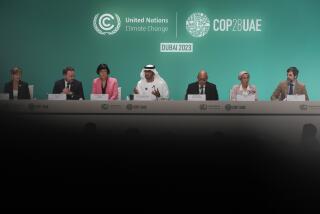Unified OPEC Walking Fine Line on Oil Prices
Gasoline is back under $1.50 a gallon just as the summer driving season nears its end, but don’t bet on pump prices staying that low. Not with OPEC back in the driver’s seat.
With the Organization of Petroleum Exporting Countries reasserting its power over global oil markets, some analysts are forecasting that crude oil prices will climb near $30 a barrel by year’s end--which could send gasoline prices back to the $2-a-gallon average they approached this spring.
Crude traded on U.S. commodities markets is priced at nearly $27 a barrel, up from a low this year of $24.70 set July 19. That upward trend will continue, said Aaron Brady, senior analyst at Energy Security Analysis Inc. in Wakefield, Mass., with prices likely to start approaching $30 again in the fourth quarter.
A key reason: A reunified OPEC--taking its cue from the leadership of Saudi Arabia’s oil minister, Ali Ibrahim Naimi--once again is keeping a tight grip on oil supplies, and therefore keeping prices to its liking.
To hear the 11-country group tell it, the cartel’s mission is to produce oil for “consumers at fair and reasonable prices.” But most industry watchers say OPEC defines “fair and reasonable” as oil prices that stay at or exceed their current levels.
That’s why OPEC--which pumps about 40% of the world’s oil--already has slashed its production three times this year, to keep a floor under prices and to ensure that an oil glut doesn’t develop as it did about three years ago, when crude prices plummeted to $10 a barrel.
Painful memories of that glut are the primary reason OPEC’s members are more closely abiding by the group’s production quotas, so prices stay at their higher levels.
OPEC has not been the only factor in sending U.S. gasoline prices on a roller coaster ride this year. Refinery outages and distribution bottlenecks are major factors in determining what motorists pay to fill their tanks. In the Midwest, for example, prices have spiked in the last week and a half after a fire crippled a Chicago-area refinery.
But with the cost of crude typically accounting for a third or more of the price at the pump, OPEC wields considerable power, especially with its renewed strength and discipline. Nevertheless, the cartel faces several dilemmas as it decides how to proceed.
First, oil’s current price level is not helping sluggish world economies and could even delay their recovery. In particular, failure of the U.S. economy to rebound and a renewed climb in oil prices could provoke the Bush administration.
President Bush has been tolerant of OPEC’s actions, but he publicly warned the cartel against pushing prices too high last month, when OPEC announced its third production cut of the year.
If prices keep going up, the Saudis--who are in the best position among the world’s top producers to tap spare capacity--might quietly pump more oil to help ease tensions with the White House. But simply nudging oil from $30 back to $29 or $28 a barrel doesn’t mean U.S. consumers would see much relief at their local service stations, analysts said.
“The Saudis are very cognizant of the impact of long-term elevated oil prices,” said Bruce Schwartz, energy analyst at Standard & Poor’s Corp. in New York. “But in their minds, getting more revenue and then feeding the world market incremental supplies [to keep prices from soaring] is preferable,” he said.
Indeed, OPEC’s priority is not the U.S. economy or American drivers but maintaining its own fortunes. Its members’ “short-term concerns are the revenues of their states, and defending the prosperity they’re trying to generate,” said Amy Myers Jaffe, senior energy analyst at Rice University’s Baker Institute in Houston.
OPEC has done so by focusing on its “reference basket,” which is the blended price of seven benchmark crude oils, six of which are produced by OPEC members. The group’s mandate is to keep the basket’s price range, or band, between $22 and $28 per 42-gallon barrel.
The seven crudes are heavier, lower-quality oils than the light, sweet crudes--such as the U.S. benchmark, West Texas intermediate--that are easier to refine and thus command higher prices. So OPEC’s basket price is typically as much as $5 a barrel less than those premium oils; it is currently about $24.30 a barrel.
The cartel signaled its determination to keep oil within the desired range last month, when OPEC ministers agreed to their latest production cut by telephone rather than wait until they meet again in person. Their next scheduled meeting is Sept. 26.
But OPEC’s defense of that price band could backfire. If the group manages to keep prices in the high-$20 range and global economies remain lackluster or erode further, demand for oil quickly could head south--creating the very oversupply OPEC dreads.
It was that glut three years ago--aided by what many consider a tactical blunder by the cartel--that was the genesis for the emboldened, powerful OPEC of today.
OPEC in late 1997 boosted its production even though Asia’s economy was collapsing. Within a year, the world was awash in oil and crude prices had plunged to $10 a barrel. That was a boon to motorists and industries worldwide, but it ravaged the economies of OPEC’s members.
The damage prompted OPEC countries to work more closely together to keep supplies--and thus prices--where they wanted them. They stayed closer to their production quotas. And they put their decisions largely in the hands of Saudi Arabia’s Naimi, a subdued but well-regarded strategist who has played a key role in reducing the bickering among his fellow oil ministers that has hurt OPEC in the past.
But there is no guarantee that Naimi can prevent some OPEC members from once again trying to take advantage of current prices by cheating on their production quotas.
In fact, Schwartz of Standard & Poor’s estimates that OPEC countries in July pumped 670,000 barrels a day more than the 24.2 million barrels that was the cartel’s quota. (With its latest production cut, due to take effect Saturday, the group’s stated daily production will drop to 23.2 million barrels. That’s down 13% from the start of the year.)
“The temptation to cheat is much higher when oil is greater than $20 a barrel than when it’s $10 a barrel,” Schwartz said.
Only Saudi Arabia and a couple of other OPEC members normally have a significant amount of excess production capacity. But now that OPEC has pared everyone’s production quotas this year, most members have spare capacity and could cheat if they so desired.
“It will be interesting to see how all those countries toe the line now that they all have some spare capacity relative to their quotas,” said Brady of Energy Security Analysis.
By working to raise prices, OPEC also runs the risk that non-OPEC oil producers--including major U.S. oil companies and the former Soviet Union nations--will try to produce as much oil as possible to capture more revenue. That could swell oil supplies and send crude prices sharply lower again.
A wild card in the upcoming oil scenario is Iraq, an OPEC member. Two months ago, the country halted its oil exports for a few weeks in a dispute with the United Nations over an oil-for-food program. That U.N. pact comes up for renewal in November, and with it the risk that Iraq might repeat its protest, which could reduce supplies and send prices for oil and gasoline higher.
“Even if OPEC acts constructively later in the year and puts more oil on the market” to keep prices stable, said Jaffe of the Baker Institute, “if Iraq changes its mind and takes its oil off the market, that could undo what OPEC intended.”
(BEGIN TEXT OF INFOBOX / INFOGRAPHIC)
OPEC’s Benchmark
They sound like flavors at Starbucks, but they’re actually the seven crude oils that make up OPEC’s “reference basket.” The cartel tries to maintain the basket’s average price between $22 and $28 a barrel, and OPEC has cut production three times this year to keep it there. Here are the basket’s crudes, and its price over the last three years:
*
Crude oil Producing nation Saharan Blend Algeria Minas Indonesia Bonny Light Nigeria Arab Light Saudi Arabia Dubai United Arab Emirates Tijuana Light Venezuela Isthmus Mexico* *
*Not an OPEC member
*
OPEC crude basket price per barrel, monthly dataJuly: $23.73 per barrel
*
*Source: Energy Security Analysis Inc., Bloomberg News
More to Read
Inside the business of entertainment
The Wide Shot brings you news, analysis and insights on everything from streaming wars to production — and what it all means for the future.
You may occasionally receive promotional content from the Los Angeles Times.










